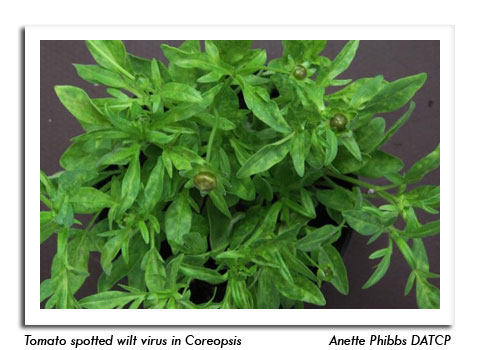
 |
|
|
Nursery & Forest
Volume 63 Number 1 Date 05/03/2018 XANTHOMONAS BLIGHT OF BEGONIA - Rieger begonias in a Washington County greenhouse were diagnosed last month with this potentially serious bacterial leaf blight. The source of the infected begonias was the global supplier Dümmen Orange, who announced on December 15, 2017 the discovery of Xanthomonas in begonia stock plants at their El Salvadorian production facilities. Although the diseased plant material was recalled, some infected plants had already been delivered to growers. Xanthomonas (X. axonopodis pv. begonia) leaf blight is specific to begonias. Symptoms include wedge-shaped lesions with yellow halos and a speckled appearance especially visible on the undersides of foliage, with wilting and blight which can progress to serious leaf loss. Preventing infected plants from entering production facilities is the preferred control. Regular scouting and rogueing are important since infected begonia may initially be symptomless. Increased air flow, appropriate plant spacing, and isolating individual begonia crops also helps to reduce or prevent the spread of the pathogen. Hanging begonia baskets above susceptible begonias can facilitate infection of plants below. Chemical control is not effective against this bacterial disease. Disposal is the only option if an accidental introduction occurs. Nursery operators are encouraged to submit symptomatic begonia plants for testing at the UW Plant Disease Diagnostics Clinic. PLANT VIRUSES - Several tenacious viruses are again appearing among early deliveries of ornamental plant stocks throughout the state. In the Dicentra or bleeding heart genus, the cultivars "King of Hearts" and "Valentine" tested positive for tobacco rattle virus (TRV), as have the Astilbe varieties "Mighty Plonie" and cultivars "Radius." Hosta hybrids "August Moon" and "Aureomarginata" were positive for Hosta Virus X (HVX), while samples of the Iris germanica varieties "Batik," "Double Your Fun," "Edith Wolford," "Immortality," "Matinata," "Rimfire," "Savannah Sunset," and "Strawberry Love" all returned positives for Iris potyvirus. The Iris pumila variety "Larrikin," Iris hybrid "Banshee," and the Mandevilla hybrid "Sun Parasol" also tested positive for Iris potyvirus. Continued diligence in maintaining virus-free breeding stock, closely checking plants for virus symptoms before purchasing, using proper pruning sanitation, and destroying infected plant materials are the best defenses. TOMATO SPOTTED WILT VIRUS - The tospovirus Tomato Spotted Wilt Virus (TSWV) was detected in April in a Coreopsis (verticillate) "Zagreb" sample. Seven thrips species have been confirmed as vectors for TSWV, with western flower thrips being the most predominant in greenhouses. The name TSWV was derived from the symptoms which develop on tomato (spotting followed by wilt), though on other hosts, symptoms may include ringspots, dark lesions on the leaves and stems, flower color breaking, stunting, and wilt. Management through elimination of infected plant material and eradication of Western flower thrips are the most important practices. Newly-acquired plant shipments should be inspected for evidence of thrips and virus symptoms before being introduced into any greenhouse. -- Tim Boyle and Marcia Wensing, DATCP Nursery Inspectors 

|
|
|